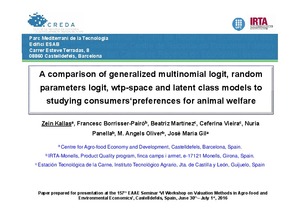Mostra el registre d'ítem simple
A comparison of generalized multinomial logit, random parameters logit, wtp-space and latent class models to studying consumers' preferences for animal welfare
| dc.contributor.author | Kallas, Zein |
| dc.contributor.author | Borrisser-Pairó,, Francesc |
| dc.contributor.author | Martínez, Beatriz |
| dc.contributor.author | Vieira, Ceferina |
| dc.contributor.author | Panella-Riera, Nuria |
| dc.contributor.author | Olivar, Maria Angels |
| dc.contributor.author | Gil Roig, José María |
| dc.contributor.other | Universitat Politècnica de Catalunya. Departament d'Enginyeria Agroalimentària i Biotecnologia |
| dc.date.accessioned | 2017-03-08T10:33:42Z |
| dc.date.available | 2017-03-08T10:33:42Z |
| dc.date.issued | 2016 |
| dc.identifier.citation | Kallas, Z., Borrisser-Pairó, F., Martínez, B., Vieira, C., Panella-Riera, N., Olivar, M., Gil, J. A comparison of generalized multinomial logit, random parameters logit, wtp-space and latent class models to studying consumers' preferences for animal welfare. A: VI Workshop on Valuation Methods in Agro-food and Environmental Economics. "Proceeding of the 157th EAAE". Castelldefels: 2016, p. 1-16. |
| dc.identifier.uri | http://hdl.handle.net/2117/102115 |
| dc.description.abstract | The European societies are requiring that animals to be raised as closely as possible to their natural conditions. The growing concerns about animal welfare is resulting in continuous modifications of regulations and policies that led to ban of a number of intensive farming methods. The European authorities consider the pig welfare as a priority issue. They are studying to ban surgical pig castration by 2018, which may seriously affect markets and consumers due to boar tainted-meat. This study analysed consumers’ preferences and acceptance regarding an alternative to castration of high-level boar-taint frankfurter sausages. Non-hypothetical discrete choice experiments was applied by creating a real shopping scenario before and after tasting the products. Data were collected for a sample of 150 consumers from the metropolitan area of Madrid, Spain. Different modelling approaches (Generalized Multinomial Logit-GMNL, Random Parameters Logit-RPL, WTP-space and Latent Class-LC models) were applied to figure out which model have the best goodness of fit. Results showed the appropriateness of the proposed alternative by using a new flavour as a masking strategy. When consumers tasted the products, they showed their willingness to pay a premium for this flavour. The WTP space model showed the best goodness of fit in terms of likelihood, Akaike information criterion and McFadden Pseudo R2. Furthermore, the degree of randomness identified by the scale parameter is also estimated. Uncertainty in selection decreased significantly after the sensory experience |
| dc.format.extent | 16 p. |
| dc.language.iso | eng |
| dc.rights.uri | http://creativecommons.org/licenses/by-nc-nd/3.0/es/ |
| dc.subject | Àrees temàtiques de la UPC::Enginyeria agroalimentària::Indústries agroalimentàries::Indústria de la carn |
| dc.subject.lcsh | Animal welfare--Europe |
| dc.subject.other | Consumers preference |
| dc.subject.other | Boar taint |
| dc.subject.other | Non-Hypothetical Choice Experiments |
| dc.title | A comparison of generalized multinomial logit, random parameters logit, wtp-space and latent class models to studying consumers' preferences for animal welfare |
| dc.type | Conference lecture |
| dc.subject.lemac | Carn -- Indústria i comerç -- Europa |
| dc.contributor.group | Universitat Politècnica de Catalunya. CREDA - Centre de Recerca en Economia i Desenvolupament Agroalimentari |
| dc.rights.access | Open Access |
| local.identifier.drac | 19697221 |
| dc.description.version | Postprint (published version) |
| local.citation.author | Kallas, Z.; Borrisser-Pairó, F.; Martínez, B.; Vieira, C.; Panella-Riera, N.; Olivar, M.; Gil, J.M. |
| local.citation.contributor | VI Workshop on Valuation Methods in Agro-food and Environmental Economics |
| local.citation.pubplace | Castelldefels |
| local.citation.publicationName | Proceeding of the 157th EAAE |
| local.citation.startingPage | 1 |
| local.citation.endingPage | 16 |



